Air Work - Microclimate & Flow
Studies
Directly observed convection currents seem to often behave more like
schools of fish than one thing pressing on another. What
that forces one to consider, at least, is whether we can describe the animated
systems of nature using our rules for how inanimate forces work. We need to leave room in our thinking for
a great variety of locally animated behaviors, given the diversity of things we
observe having complex organization and dynamic change. If not
apparently displaying external pushes and pulls, they'd implicitly need to be
behaving according to their own internal organization, that would naturally be
hidden from view within the systems exhibiting the behavior. Their animation
would implicitly be coming from their own emergent organization, as they exploit
the gradients giving them energy. 2011 JLH
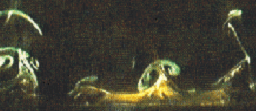 We can trust the conservation of energy, but not
the conservation of order, and it clearly appears that newly developing
organization is needed for spontaneous energy transfer processes, visible in how
they grow organically.
We can trust the conservation of energy, but not
the conservation of order, and it clearly appears that newly developing
organization is needed for spontaneous energy transfer processes, visible in how
they grow organically.1999 This
is basic empirical physics concerning passive (uncontrolled) fluid flow and the
evolving
flow structures that can develop in ordinary circumstances, largely done in
1977-79
.
The basic finding it that there are all manner of common flow
patterns
you would simply never find in a fluid mechanics lab, that is....,
unless
you looked around in the doorways, near the floor, walls and ceilings
or
for the currents that travel in-between..... P.F.
Henshaw
Call them micro weather systems perhaps, but they also raise some
macro theoretical problems....
Introduction
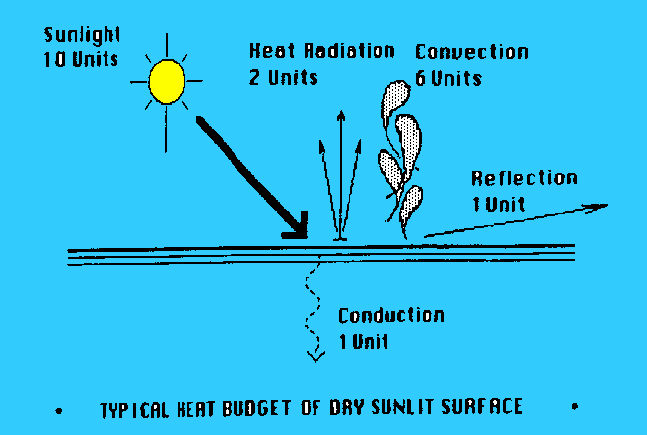 1999 My
introduction to microclimate research came from a curiosity about the
wonderful
environmental design characters of Brooklyn's Prospect Park, one of the
jewels of Frederick Law Olmsted. and Calvert Vaux's invention of
American
landscape design. It gave me a subject for a model building
and analysis project while studying architecture at the Univ. of Pa. in
Philadelphia. A unique microclimate exists at a forest edge,
where
the mix of qualities of both exposure and seclusion invite a certain
group
of plants and animals, and a certain group of human
activities.
I also developed a course of study for architects. There are two
tasks in microclimate study, understanding the climatic characters of a
place, charting its energy transfer mechanisms and calculating its
energy
budgets.
1999 My
introduction to microclimate research came from a curiosity about the
wonderful
environmental design characters of Brooklyn's Prospect Park, one of the
jewels of Frederick Law Olmsted. and Calvert Vaux's invention of
American
landscape design. It gave me a subject for a model building
and analysis project while studying architecture at the Univ. of Pa. in
Philadelphia. A unique microclimate exists at a forest edge,
where
the mix of qualities of both exposure and seclusion invite a certain
group
of plants and animals, and a certain group of human
activities.
I also developed a course of study for architects. There are two
tasks in microclimate study, understanding the climatic characters of a
place, charting its energy transfer mechanisms and calculating its
energy
budgets.
One may sit on the porch on a summer evening,
unaware
of the passing of time until the late stillness of dusk is broken by
the
first night breeze. This is one of the more reliable microclimate
markers
of the procession of the day in passive environments. It
may
pass unperceived. It is also as often responded to
unaware.
It serves as a reminder of time passing after a period of time
suspension,
occurring at the end of the evening still. Markers and characters
such as these serve as links between the physical mechanisms of a day,
the character of a place, and the quality of personal experience.
In learning how to design passive solar homes
it
seemed quite natural to consider them as microclimates, made unique
because
they are enclosed. I carefully studied a number of both
solar
and non-solar homes to see where the energy collected and how it
traveled.
In the process I stumbling upon a wide field of undocumented
kinds
of air currents, some that might materially effect the enjoyment of a
home
or how it could be heated or cooled.
The homes most carefully studied were in
Denver
and New Mexico, using a chart recorder to trace temperatures and air
velocity
in 24 locations. One of the first observations was that the
movement
of energy in enclosed spaces is highly eventful, exhibiting complex
successions
of temporarily stable patterns. An introduction to the detailed study
of
air current networks follows. Sometimes a great deal of heat
would
be found traveling along very narrow pathways, seemingly contrary to
the
physical laws of convection. A way to reproduce one of
these
provided the basis for an experimental device
for
unusually high efficiency heat transfer.
Air
Current Network
Research
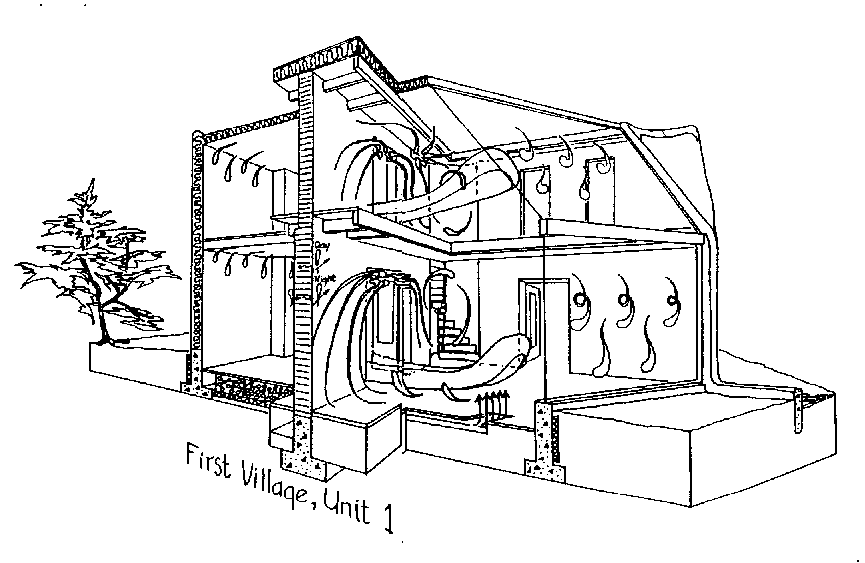 A
description of the behaviors found in two of the building climate
studies,
Air
Current Networks, was originally presented at the 1978
International
Solar Energy Society meeting and was published in RAIN magazine of
Portland
OR, and re written in 1984. It describes some of the air current
phenomena
which seemed to be responsible for two solar homes working better than
expected.
A
description of the behaviors found in two of the building climate
studies,
Air
Current Networks, was originally presented at the 1978
International
Solar Energy Society meeting and was published in RAIN magazine of
Portland
OR, and re written in 1984. It describes some of the air current
phenomena
which seemed to be responsible for two solar homes working better than
expected.
One of the starting points for critical
thinking
on the subject is to distinguish between the pathways that develop and
the currents that travel through them. Many kinds of convective
pathways
have unusually distinct boundaries, often exhibiting thresholds of
stability.
These include things like the chimney that develops in a quiet air mass
around the plume of warm air continually rising above any stationary
person.
Initially there is no regular pathway for the rising current, and then
some particular pathway develops and stabilizes. It may reach the
ceiling,
and may not, but the pathway and the current moving through it
co-evolve.
It may join with paths for rising currents from other sources or not.
If
the person moves, the pathway that previously developed above them may
remain for a while.
One of the rare examples of the kind that is
commonly
observed can be seen in the patterns of smoke rising from a recently
extinguished
candle, or other smoldering ash. Sometimes the smoke stream can be seen
rising in a straight line, to then suddenly tumble in meandering
turbulence,
perhaps a foot above the source. If the room is calm the point at which
the tumbling develops will rise higher and higher. Then a wobble will
develop
somewhere lower in the column, and that becomes the point at which the
tumbling starts. The length of the fluid chimney, and the streamlined
column
rising within it, varies. Sometimes the structure grows, becomes
unstable
and collapses repeatedly. Without the formation of a columnar pathway
the
stream would billow about immediately from the bottom, another pattern
that is frequently observable.
On a much larger scale there are things like
cumulus
clouds. If a chimney in the air below the cloud hadn't developed,
providing
a central pathway for warm air generated over a large area of the
ground,
there wouldn't be these enormous thunderheads billowing in the sky.
It's
the invisible chimney below the cloud and its central column of rising
air that produces them. What we usually see of it is only the
condensate
at the top, where the virtual chimney structure ends and the rising
column
of air flattens out. There are also more unusual convection chimney
phenomena,
like cumulus cloud down drafts, where massive invisible currents of
cold
air plummet toward the ground. These have sharp invisible boundaries
that
aircraft may cross without any warning, and often find fatal. There is
also weather that occurs in fires. The term "back draft" is probably
familiar,
referring to explosive changes in the convective pathways. The term
"super-heated
air" refers to fire that spreads through air passages, jumping multiple
floors at a time without setting fire to materials in-between.
The usual explanation for why these behaviors
remain
difficult to describe and predict from the scientific laws is that
evolving
systems display a critical sensitivity to initial conditions. Both
turbulence
itself, and the more discretely patterned flows of both large and small
scale weather systems, remain largely intractable to mathematical
modeling
because they concern spontaneously evolving unique individual events.
What one might call my 'moment of discovery'
is
worth retelling. It was not when I first recognized the unusual woven
sheet
current sliding up an adobe wall that I have called 'structured
convection'.
It was when I was watching two very gentle convection currents (moving
at most 4" per second) which were making alternate use of the same
upward
pathway. They were gathering from sunlit patches on a floor and both
rising
near the corner of the room. One would flow briefly (~1 liter volume),
until it depleted its local reserves and then the a flow from the other
source would take over, back and forth using the same pathway in fairly
regular alternation. Individual air currents frequently cross pathways
and gently 'gurgle' through openings, somewhat like water pouring from
a jug.
There was a time when the right hand current,
for
some reason, missed its turn at the opening and a second pulse in a row
came in from the left. Then a stronger than normal pulse developed from
the right hand current, but blocked by the momentum of the flow from
the
left, it broke out in a new direction as if to travel upward on a new
path.
Then it stalled a foot or so above the floor. Just as the smoke trace
that
enabled me to visualize this movement was fading beyond recognition I
saw
the wayward pulse dip back toward its original normal pathway,
apparently
filling the gap in the larger system of flows its absence had left
behind.
This was self-correcting systematized flow! Having found what to look
for
I then began to find it in many places.
Devices Using Structured Convection ..... (a
bounded convective wall jet)
e-mail
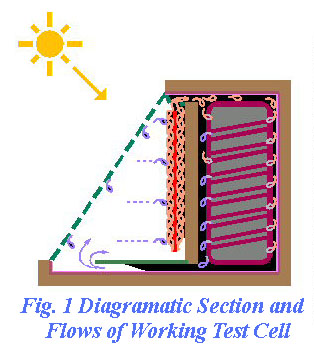 1999 Perhaps it should have been difficult to restrict
otherwise turbulent wall convection
to a thin boundary layer stream 1/8th as thick and 8 times as fast
as expected for normal turbulent boundary layer flow. It was
actually fairly easy. You
do it by clearing the pathway for ejections to follow, drawing air
through a narrow
slit along the streamwise edge of the surface, not by somehow
restricting
the turbulent motion. It's been the documentation
that
has been difficult.
1999 Perhaps it should have been difficult to restrict
otherwise turbulent wall convection
to a thin boundary layer stream 1/8th as thick and 8 times as fast
as expected for normal turbulent boundary layer flow. It was
actually fairly easy. You
do it by clearing the pathway for ejections to follow, drawing air
through a narrow
slit along the streamwise edge of the surface, not by somehow
restricting
the turbulent motion. It's been the documentation
that
has been difficult.
I wholly miscalculated the level of disbelief
that
the claim would generate. Air flow patterns are quite hard
to document without specialized laboratory equipment and cooperating
engineering
expertise. All I have for proof are thermocouple
chart recordings
which display otherwise impossible behavior. What I was
able
to learn by way of painstaking observation with smoke tracers
taught
me much more, but is hard to document.
I've called it "structured convection", a
name
of convenience. The advantage gained is
that
the thermally charged portion of the working fluid can be removed from
the reservoir without the turbulent mixing. Neither the
reservoir
nor the current become thermally polluted (by mixing with each
other).
It greatly improves the heat transfer efficiency.
This
might have diverse useful applications, including things like
controlled
chemical deposition as well as heating and cooling applications.
Only some basic facts are known about the
detailed
structure of the bounded convection layer. Rhythmic
patterns
that allow working fluid to pass through the wall layer without
interrupting
it can be directly observed, along with its very narrow thickness and
high
velocity. What causes it is drawing fluid at the
right
rate from a slit along the streamward edge of a heat transfer
surface.
Given the right conditions a layer of organized turbulence propagates
over
the whole surface.
For those who carefully think about it,
reasonably
good proof is provided by an anomaly found in thermal chart
recordings
of the solar collector test cell. When the test cell was
operating
as a passive convection loop, at around 2:00 PM, the temperature of the
chamber shot up 40 degrees F. The question is why the
temperature
went up so rapidly at the point where the solar gain was in
decline.
Something had to occur to suddenly reduce the efficiency of heat
transfer
to storage. Only a sudden change in the convective pattern
is available to explain it.
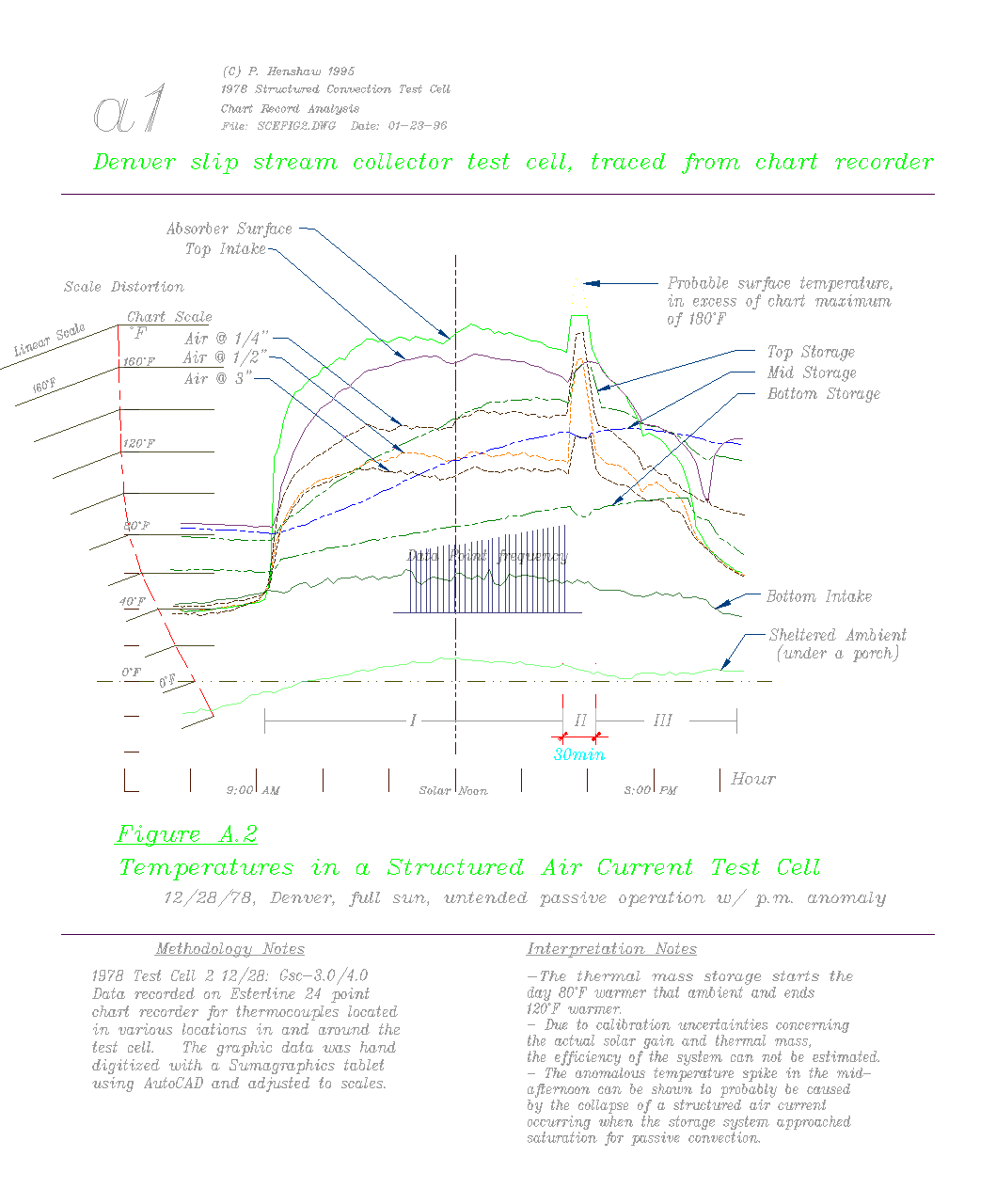 As
seen in the chart (fluew1.gif click to
enlarge),
the shape of the temperature spike, in the middle of a bright and
clear afternoon, is entirely inconsistent with any change of energy
input.
A second clue is that at the same time as the temperature on the
absorber
side shot up, the temperature of the heat storage mass began to
decline.
The rate of heat transfer between the two sides of the cell evidently
collapsed,
leaving the incoming energy to build up in the collector
chamber.
What explains it is that as the sun began to wane the heat storage mass
gradually approached saturation. At a point where the draw along
the top edge fell below a critical level, the currents formerly rising
in tight formation near the absorber surface became disorganized and
spilled
out into the absorber chamber, causing its temperature to suddenly
rise.
As
seen in the chart (fluew1.gif click to
enlarge),
the shape of the temperature spike, in the middle of a bright and
clear afternoon, is entirely inconsistent with any change of energy
input.
A second clue is that at the same time as the temperature on the
absorber
side shot up, the temperature of the heat storage mass began to
decline.
The rate of heat transfer between the two sides of the cell evidently
collapsed,
leaving the incoming energy to build up in the collector
chamber.
What explains it is that as the sun began to wane the heat storage mass
gradually approached saturation. At a point where the draw along
the top edge fell below a critical level, the currents formerly rising
in tight formation near the absorber surface became disorganized and
spilled
out into the absorber chamber, causing its temperature to suddenly
rise.
In the test cell there was a fan available to drive the flow, and
the
record shows that when the fan was then turned on the temperatures of
the
cell returned to the previous levels, causing the temperature of the
storage
to begin rising again. This verifies that the collapse in
heat
transfer rate was due to a decline in the total air flow, and that the
more efficient form of air flow was restored when themass flow rate was
restored. (for a longer discussion see stcevid.pdf
)
The
working test cell Original indicators of behavior and
efficiency
fluewall.gif
Perspective sketch of the test cell
fluewal1.gif
Diagram showing dimensions and probe locations
Test
Cell Thermal anomaly,
analysis of sudden rise
in temp as incoming energy waned
78cell.txt 12 point temperature data for
thermal
anomaly
fluew1.gif
Full day temperature record of behavior with anomaly
fluew2.gif
Key temperatures & gradients
fluew3.gif
Temperatures vs. gain / rates of heat flow
S. Green
Expectation of normal flow by
crSmith1.pdf Letter of support
Patent
pending, (PDF file) Patent
specification
Figures - 1a,b 2
a,b 3a 3b3c
...
Technical Abstract:
Otherwise turbulent and disorganized convection currents in a
fluid
medium of larger dimension become confined in an organized accretion
flow
structure hugging a heat transfer surface as a consequence of
appropriately
aspirating the natural convective flow.. In the conditions investigated
the resulting structured ‘sheet current’ had nominally eight times the
velocity and 1/8 the thickness of the theoretically normal turbulent
boundary
layer and entirely inhibited the normal convective movement of surface
boundary currents into the surrounding medium. Applications include
reducing
the size and raising the efficiency of fluid heat transfer devices and
heat assisted control of mass fluid flow pathways.
Surprising
Elementary Structures
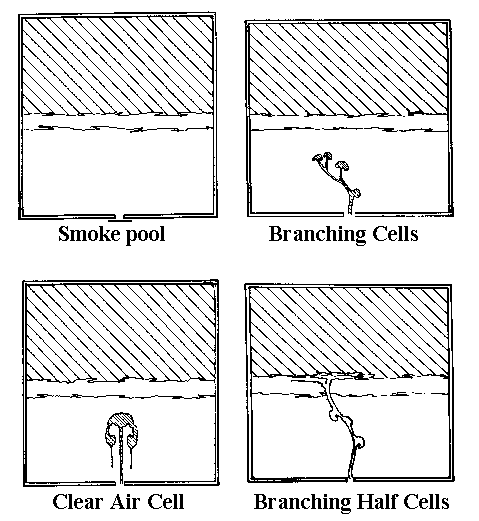 1999 Air
motion is usually complex, if only because any air that moves has to be
replaced. That results in swirling flow and counter flow.
1999 Air
motion is usually complex, if only because any air that moves has to be
replaced. That results in swirling flow and counter flow.
In exploring how the paths of air flow
develop,
a number of small test cells were made. One of the more
successful
was a simple 4" square by 3/4" deep hollow plexiglas box (gluing
together pieces of 1/8" plex). Openings were provided on the top
or bottom as needed and smoke from a cigarette or incense stick was
introduced.
The image at the left shows smoke filling the bottom half of the
container,
and then a pulse of clear air rising through the smoke pool from a
momentary
opening at the bottom.
These and a other
examples
are displayed and discussed in more detail. The series of
sketches
was once called 'Mostly Nonsense' because of the strange conundrums
that
they pose. In the first example one might ask why smoke,
that
rises in open air, would lie in the bottom of a container at room
temperature.
It just doesn't seem to make sense...
The Development an Individual Air Current
There are two primary kinds of natural
convective
motion. One is motion directly due to the change of density due
to
temperature, and the pressures of buoyancy that result. The
other,
is the following development of organized patterns of flow and
counter-flow.
These include intricately layered shapes and small scale 'weather'
systems
of various kinds.
The most common and most compact form of fluid flow system is a
'vortex
ring', something like a smoke ring. Vortex rings are
sometimes
complex, but orderly systems of coiling laminar flows, one of the main
constituents of the highly complex flows of 'turbulence'.
It
is usually thought that well ordered air flow is laminar (layers
sliding
by each other smoothly). With large differences in speed between
adjacent layers, laminar flow becomes unstable and systems of
interaction
develop, filling the region with vortex rings and other complex
twisting
motions.
Isolated individual vortex rings can develop spontaneously at static
inversion instabilities and elsewhere. There they develop
as
a mechanism of creating a path through which warm air can rise, acting
as air 'tunneling bodies', a design for opening a temporary channel of
flow through an otherwise static barrier. A simple diagram of
one,
is depicted in 6 stages of development and passing.
Please note, the shapes shown do not closely match what you will
most
normally observe, but are idealized to clearly show the main parts of
the
succession that you should look for. (click figures to enlarge -
From "An Unhidden Pattern of Events" 1979)
-
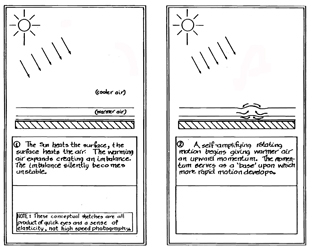 first disturbance in
static, but
unstable inversion
first disturbance in
static, but
unstable inversion
-
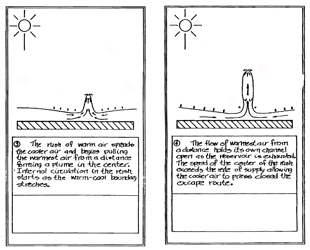 development of
vortex
ring
propagation
development of
vortex
ring
propagation
-
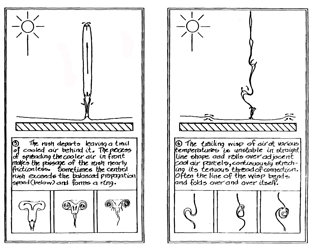 travel and remains
travel and remains
for more discussion see Discussion
in field research paper
Back to top, Open
Systems Physics (Overview & perspectives) Physics of happening
(research methodology)
 1999 My
introduction to microclimate research came from a curiosity about the
wonderful
environmental design characters of Brooklyn's Prospect Park, one of the
jewels of Frederick Law Olmsted. and Calvert Vaux's invention of
American
landscape design. It gave me a subject for a model building
and analysis project while studying architecture at the Univ. of Pa. in
Philadelphia. A unique microclimate exists at a forest edge,
where
the mix of qualities of both exposure and seclusion invite a certain
group
of plants and animals, and a certain group of human
activities.
I also developed a course of study for architects. There are two
tasks in microclimate study, understanding the climatic characters of a
place, charting its energy transfer mechanisms and calculating its
energy
budgets.
1999 My
introduction to microclimate research came from a curiosity about the
wonderful
environmental design characters of Brooklyn's Prospect Park, one of the
jewels of Frederick Law Olmsted. and Calvert Vaux's invention of
American
landscape design. It gave me a subject for a model building
and analysis project while studying architecture at the Univ. of Pa. in
Philadelphia. A unique microclimate exists at a forest edge,
where
the mix of qualities of both exposure and seclusion invite a certain
group
of plants and animals, and a certain group of human
activities.
I also developed a course of study for architects. There are two
tasks in microclimate study, understanding the climatic characters of a
place, charting its energy transfer mechanisms and calculating its
energy
budgets.
 We can trust the conservation of energy, but not
the conservation of order, and it clearly appears that newly developing
organization is needed for spontaneous energy transfer processes, visible in how
they grow organically.
We can trust the conservation of energy, but not
the conservation of order, and it clearly appears that newly developing
organization is needed for spontaneous energy transfer processes, visible in how
they grow organically. A
description of the behaviors found in two of the building climate
studies,
A
description of the behaviors found in two of the building climate
studies,

 1999 Air
motion is usually complex, if only because any air that moves has to be
replaced. That results in swirling flow and counter flow.
1999 Air
motion is usually complex, if only because any air that moves has to be
replaced. That results in swirling flow and counter flow.


